Back when dinosaurs roamed the earth and every product was the first of its kind, getting new customers was no problem.
Business was booming. Competition was minimal. Dino salesmen were dining on tender, bloody brontosaurus steaks every night.
So it didn’t matter when some of those original customers eventually stopped buying. Because there were always more dinos to sell to.
Table of Contents
In case you hadn’t noticed, things have changed
Fast-forward a couple hundred million years, and the world of sales and marketing is a teeeeensy bit more competitive. (The upside: we’re not usually worried about getting eaten.)
We all know it costs more to acquire a new customer these days than to keep the old ones helplessly, gratefully entangled with you and your business.
But for some reason, too many businesses still focus most of their energy on the flashy, sexy acquisition part of the funnel — forgetting that they’re spending up to 7x more money to convert new customers while it’s actually 5X more cost effective to retain a customer than to acquire a new one.
If you’re emphasizing conversion metrics like initial signups and sales over all else… you might inadvertently be leaving your existing customers to fossilize.
Add that “7x” simple math to the fact that competition is fierce in virtually every industry these days, and you’ll start to understand why non-transactional interactions with your customer are more important than ever (Braun et al, 2016).
Non-transactional interactions can include:
- Offering help
- Asking for feedback
- Congratulating a user on progress
- …anything that doesn’t involve a user’s money
In the great, albeit slightly dry words of this article with an extremely long title:
“It is no longer enough for marketers to create value and make profits in selling products and/or services to customers; they must co-create value with customers.”
[x_line]
Emails are a no-brainer for retaining your existing customers… so why aren’t you optimizing them?
Your user has already hit her “Aha!” onboarding activation moment.
She’s seen the value in what you’re making, and what you could help her become.

UserOnboard
Now you’ve got to keep that user engaged and interested, and prevent her from wandering away. (Fire flowers only last so long).

Enter: retention emails…
In most cases, your user’s email address will be the most powerful tool you have to keep her from leaving you completely.
But…what should you actually WRITE in your retention emails?
In this post, we’ll go over…
- The types of content you should be sending in your retention emails
- How to match that content to users depending on their behavior and engagement levels
- And what to do if when they actually slip away
[x_line]
4 Types of Email Content that Increase Retention
Retention is about helping your users continue to get value from you or your product.
It’s about getting them back INTO your product or back ONTO your website. And it’s about helping them when they have trouble.
Here are four approaches to consider trying in your retention emails.
[easy-tweet tweet=”4 Types of #Email #Content that Increase Retention:” user=”punchlinecopy”]
#1 Add interactive elements
Interactive emails can increase retention by boosting in-email engagement.
Get your user to click something in your email, and boom, they’re back in your app or on your website where they belong.
You’ll see this a lot with “video” thumbnails that are actually just links to the video (hosted elsewhere).
Like this email from Spark, which boasts a “play” button that links to Vimeo:
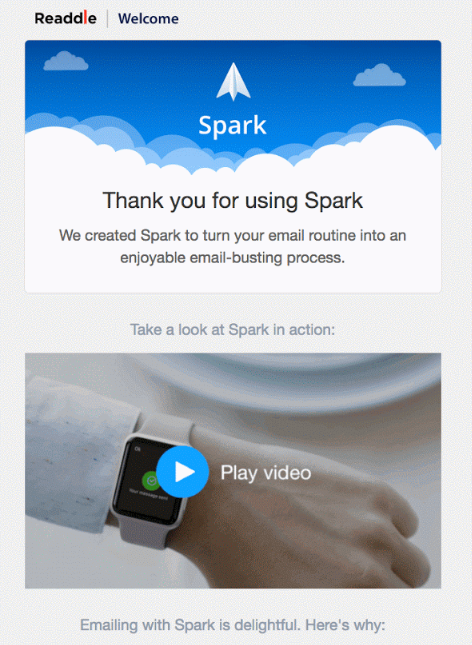
Ahhhh, you tricked me! OK, I’m watching now. See the live email here
Image via Really Good Emails
Here’s a company called 1973 Ltd. sending probably the most clickable email I’ve ever seen:

Who’s Smiles Davis? Who cares!
Image via Really Good Emails
Your user clicks a thing. Suddenly, he’s magically re-engaged with your app, service, or brand! (If only romance were so easy to rekindle.)
Whether it’s a video, a mystery gift tag, a simple link, an opinion poll, or something else — whether you accomplish it through sticky copy or clever design or both — try making at least one of your retention emails irresistibly clickable.
Bonus for overachievers: you can use any click data you gather to segment or tag your users by interest.
[x_line]
#2 Turn engagement into a game
Take interaction a step further by gamifying your emails. Gamelike elements — like points, badges, storylines, rankings, etc. — can add fun and adventure to any campaign. And you want your users to have fun, don’t you?
(Yes, “gamification” is a sparkly buzzword. It can still work for you.)
What does it mean to gamify your user retention program? Kissmetrics summarizes:
“[I]n a nutshell, gamified systems must:
- Give users motivation to do something (emotional investment, promise of reward, etc.).
- The ability to complete the action.
- And finally, a trigger or cue to complete the action.”
Example time: Grammarly sends something I like to think of as a “Super Weird Hail Mary Email” to users who have gone inactive.
It’s a badge that users “unlock” after a long period of time NOT using Grammarly.
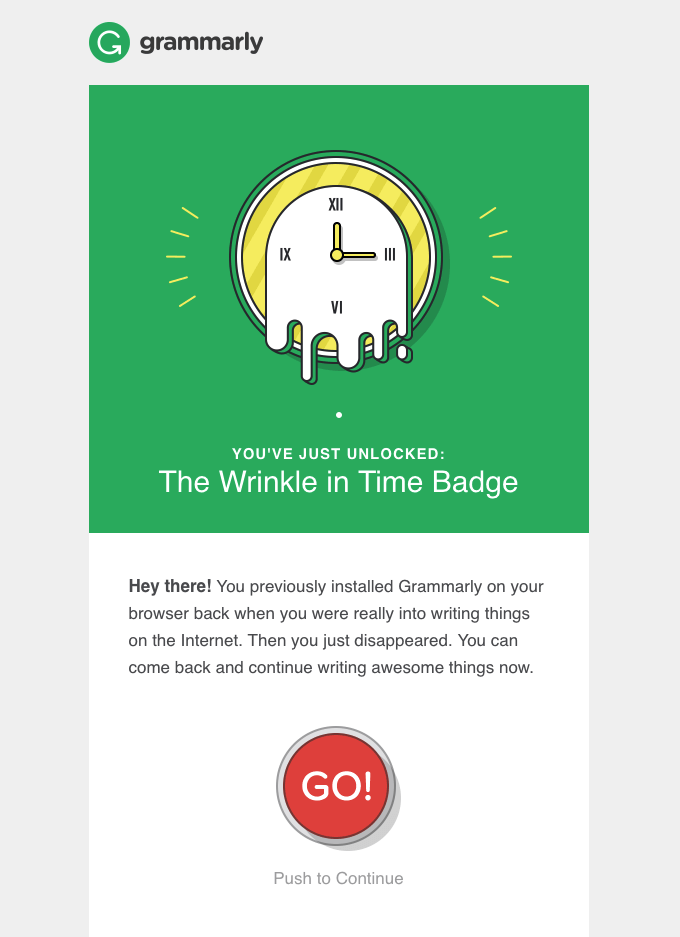
“You can come back now.” Stop saying it to your ex, and start saying it to your users.
Image via Really Good Emails
In case you’re not sure what just happened because it was so slick, you just saw Grammarly take a handful of big fat lemons (aka user stagnation) and crush that sh** into delicious lemonade (aka a reminder of the value they provide and a zingy taste of their playful culture).
Here’s a board-gamified Taco Bell holiday promotion that even I would have enjoyed receiving:
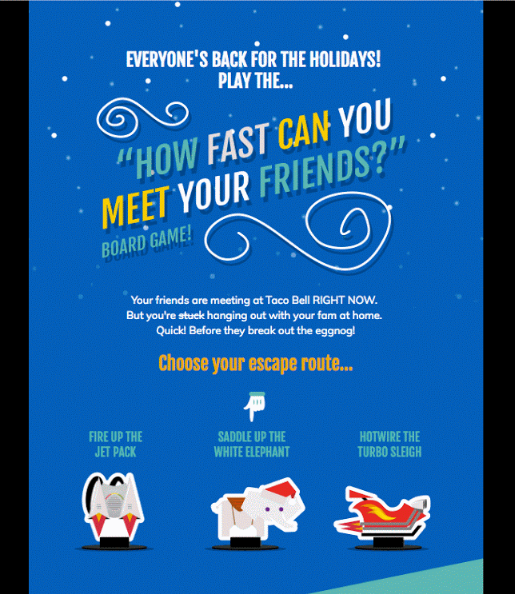
Image via Really Good Emails
[x_line]
#3 Send social proof
Sometimes, people leave a product or service because using it feels like screaming into the void. And nobody needs more of that feeling.
Sending proof that your solution is helpful for other people (who are just like your reader) can sometimes nudge that reader back onto the right path.
It’s another taste of that sweet, effective little “you’re not alone” copy nugget we all love so much.
Of course, there are right ways and wrong ways to use social proof.
Check out how Payoff incorporates social proof in the form of a testimonial at the bottom of, fittingly, a support email:
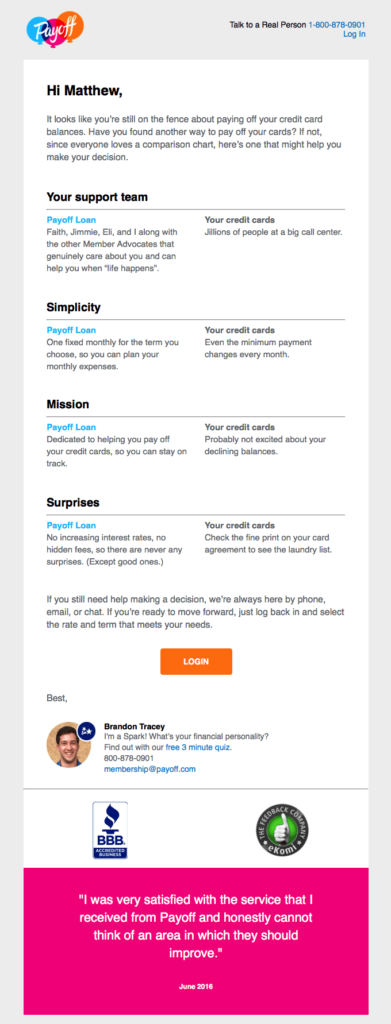
Image via Really Good Emails
Granted, the testimonial’d be more convincing if it were attached to a person with a name and a face. Assuming this person has those things.
Highbrow, a service that delivers “bite-sized courses” to your inbox daily, sends an email saying, “Look what’s popular.” Because people tend to do what other people are doing.
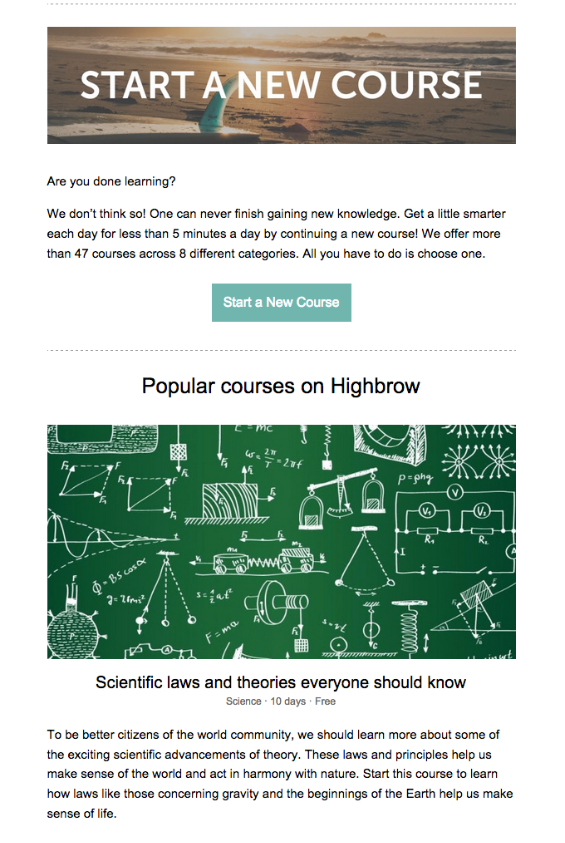
Hey, if it’s popular, it must be good, right?
Image via Really Good Emails
[x_line]
#4 Ask for feedback
Q: Should you ask for feedback from all of your users regularly?
A:
- Yes.
- Why would you not?
- Seriously, why would you not?
Along with reminding your user that there are living, breathing humans behind the slick, designy email template you’re probably using, asking for feedback has 3 other key positive effects:
- It creates gratitude and buy-in (you’re familiar with the principle of reciprocity, right?)
- It gives you IMMEASURABLY VALUABLE voice-of-customer research to mine for your copy
- It illuminates unexpected ways people are using your product, potentially informing future feature development or pivots
[x_line]
Now, match the right type of content to the right user
“OK, Lianna,” you sigh, running your hands through your luxurious mane.
“But… what feedback am I looking for? What should I ask my users?”
BOY AM I GLAD YOU ASKED.
Whether you run a service business, a product business, or some weird blend of the two (hello, tailored subscription boxes) — here are 3 questions that cannot lead you astray when you’re looking for valuable user feedback:
- What was going on in your life that brought you to us?
- What other solutions have you tried to solve this problem?
- What do you need [OUR PRODUCT] to do for you?
Once you’ve got that data, sit on it forever.
JUST KIDDING. Please do all of us a favor, and use this solid-gold info to inform your actual product or service, and how you market said product or service.
[x_line]
Map out your retention email flows by behavior
OK, now you’re getting an idea of what types of retention content you can send.
But you don’t want to send the same types of content to everyone. You should modify what you send, and how often you send, by your users’ different levels of engagement.
Let’s dig into 3 user behavior archetypes:
- The Super-Engaged, “God I Adore You” User
- The Hot-N-Cold, “Meh, I Could Take It or Leave It” User
- And the “Bihhh, I’m Outta Here” User
But first…
STORY TIME! (AKA, why you need to segment users in your retention emails)
Imagine you’ve just launched Blurbelpork’s Grease-Free Online Sausage Counter.
This revolutionary new tool will allow you to count how many sausages you own — anytime, anywhere, without having to get your hands all lardy or deal with weird stares from Judgy Patricia!
Butchers, barbecue buffs, and bearded men named Bill everywhere are buying into your tool, HARD.
Bill is your most engaged user. He blazes through every email and every offer before you even have a second to say, “Wait, why would anyone need a virtual sausage calculator?”
Bill comes back every day to count his sausages. He spends tons of time on your site. He probably emails you pictures of his sausages at least once.

Proud Papa
Bill obviously doesn’t need the same kinds of nurturing emails as a different type of user (let’s call her Meh Melissa), who signed up for Blurbelpork, used it once, and hasn’t returned since her first fateful sausage tally.
Meh Melissa needs encouragement, handholding, a reminder of why Blurbelpork is crucial. Bearded Bill does not need any of these things.
So don’t send Bill the same kinds of emails you send Meh Melissa, and vice versa. Ya dig?
[easy-tweet tweet=”What sausages have to do with #SaaS #retention:” user=”punchlinecopy”]
This happened to me in real life recently.
A program I signed up for, which is billed as a “take it at your own pace” thing, but which actually has a weekly structure, kept sending me emails congratulating me on completing various modules.
The only problem…
I hadn’t completed that module.

So much enthusiasm for something that you should know I did not do!!!
Or this one…

I was not doing awesome. I was doing nothing.
[x_line]
OK, now back to your regularly scheduled user behavior archetypes.
Pro tip: If you’re searching for a tool to help you segment your user behavior, check out Intercom.io and userengage.io, both great platforms for personalizing the experience for your customers.
#1 The Super-Engaged, “God I Adore You” User
Remember Bill? This is Bill.
He’s actively using your product every day or every week, opening your emails, and clicking.
This user blazes through every email you send and every CTA you offer him. He’s actively using your product every day or every week.
He might even be emailing support with helpful feedback or suggestions (which, like, OK that’s nice, but you’re blowing up my PureChat subscription, guy).
If this were grade school, he’d be earning extra credit out the wazoo.
How to retain the Super-Engaged User:
Short answer: Keep doing what you’re doing, superstar!
As long as you keep the focus of your retention emails on providing value, you’re likely golden. This user gets you. He values you. You can do no wrong in his eyes, so just don’t make any bad moves, K?
Want to earn some extra credit of your own? Try sending these types of emails to the Super-Engaged User:
- Suggestions for new, different, or more advanced ways to use your product
- Offers for new products/services, or upgrades (come on — they’re basically begging for it)
- Special invitations to create more of that juicy psychological buy-in
- Referral codes, programs, or incentives for him to share your service with his friends and turn him into a gat-damn brand ambassador (give that fool a free T-shirt)
Also, this is a spot where gamification can come in super handy. You’ve earned the user’s trust and participation — so it’s high time to add some fun into the mix.
Par exemple:
Because I am a drone who obediently clicks through every marketing survey I get, Freshbooks recently invited me to join a secret community where they’ve gamified the process of collecting my personal information.
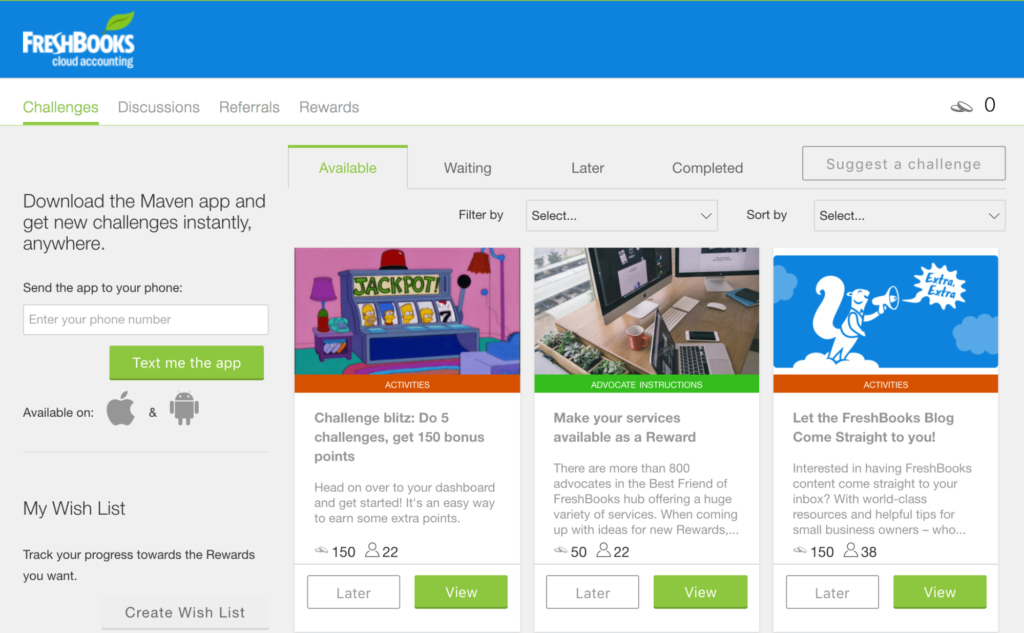
Assuming I visit the community regularly, this should be a perfect symbiotic relationship:
- Freshbooks gets valuable user data, ostensibly so they can serve me better
- I get to feel like I’m part of something secret and fun, and I ALSO know they’ll be there in a heartbeat if I ever have a problem, because Clearly I Am Very Important
(Although, Freshbooks, if you’re reading this: You haven’t sent me any reminder emails about this “special community” since my first login. It’s starting to feel less special. Can I help?)
[x_line]
#2 The Hot-N-Cold, “Meh, I Could Take It or Leave It” User
Remember Meh Melissa (Meh-lissa, if you will)?
This user is someone who’s had a couple of minor wins using your solution, but isn’t actively using it or returning as often as you’d like.
She’s not sold on the idea that your product is something she NEEDS. Something ESSENTIAL.
Something that will continue to shower her in benefits until she drowns happily in a sea of bourbon and marshmallow Peeps.

I want to go to there.
When you’re trying to figure out what to send to this type of user, analyze her in-app or on-site behavior.
Does she always bounce from a certain screen or page? Is there a milestone or progress marker she just can’t seem to get past?
Knowing this data (and, ahem, using it) can give you insight into problems with your solution or the way you’re presenting it (your UI).
So, how can you retain this extremely ambivalent user? Try sending her these types of emails:
- Ask her what she wants…
- … but don’t just rely on that — because often, she might not know what she wants, or how to articulate it
- Give her quick wins
- Offer support
Wistia combines an offer of support WITH the opportunity for a quick win in one of its retention emails:

Woof, Wistia.
Image via Really Good Emails
MailChimp offers similar support:

Image via Really Good Emails
[x_line]
3. The “Bihhh, I’m Outta Here” User
Welp, it had to happen sometime.
This user activated. Then he peaced the f*** out of your solution (let’s call him Peace-Out Perry) and now you’re crying, because you know if you could JUST show him how helpful you are… etc, etc.
Your #1 goal with this Borderline Abandoner is to remind him of the problem he had that caused him to sign up in the first place —
— and then agitate that problem until he CANNOT STAND IT ANYMORE and logs in to fix it.
[easy-tweet tweet=”Here’s what to include in your #SaaS retention #emails:” user=”punchlinecopy”]
Show Peace-Out Perry other people just like him who are seeing huge benefits from your solution. Make him feel like he’s not alone…
In your last-ever hurrah before he unsubscribes, try sending Perry emails that:
- Remind him of the problem HE STILL HAS, and why he signed up
- Offer support, and actually follow through
- Contain a discount or special offer
- Ask what happened
Here’s Skillshare with a pretty compelling winback offer:

Image via Really Good Emails
And here’s the cryptically-named TunnelBear asking what they could have done better:
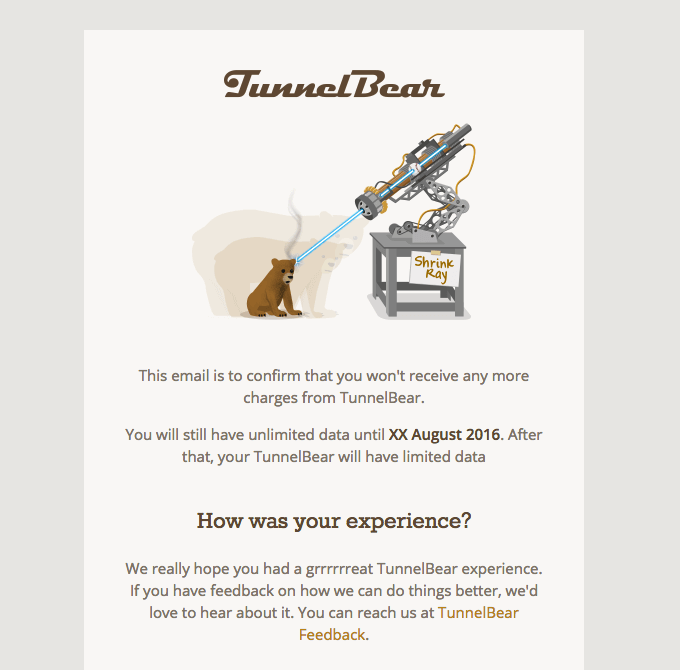
Image via Really Good Emails
BONUS: If you can’t bring Peace-Out Perry back from the dead, it’s time to do some grave robbing
[x_line]
If you can’t bring Perry back, and he ends up abandoning you, it’s time to switch gears to research mode.
Find out why he left, so you can take steps to keep the same thing from happening to your still-living, still-breathing users.
My friends Joel and Josh did this exact same forensic research in their recent work with HubSpot.
They interviewed “dead” HubSpot account owners alongside active users — because a lot of the time, people who LEAVE you are the ones who can tell you the most about your flaws.
Stop thinking about your ex, stop thinking about your ex…
If Peace-Out Perry has canceled his account or gone inactive for a while, he’s as good as dead and buried.
Now, the one thing you can do with that all-powerful email address is try to figure out why he left (and how you can keep it from happening next time).
Ask offboarding questions like…
- How did using our product/service make you feel?
- How can we make our product/service better?
- Are you using something else to fix your problem? What is it?
[x_line]
Don’t want to market like a dinosaur? Focus on these retention emails
And you might just turn this user:

Into this one:
[x_line]
Lianna Patch is a conversion copywriter and comedian whose greatest dream is to make your customers pause, smile, and click (in that order). Conquer campaigns with her at Punchline Conversion Copywriting, or get quick copy jobs done at SNAP Copy.
Facebook Comments
Powered by Facebook Comments




Thanks for the great examples of retention emails. I especially like the ones that include video to encourage interaction. It’s definitely becoming one of the more popular types of media to help with conversion.
Agreed! And platforms like Wistia and Facebook are making it easier and easier to tie video to trackable conversion metrics. Thanks for reading, Melissa 🙂
Great article Lianna!
I love the example by Mailchimp.
Any suggestions for metrics we should track for these types of retention emails?
Great read Lianna! Thanks for sharing!
Thanks for sharing. Great examples and very useful information and tips.
What an interesting post you have shared here, Lianna! You can’t allow your customers to turn into fossils. Emails are the saviour when it comes to customer retention.
Kathy